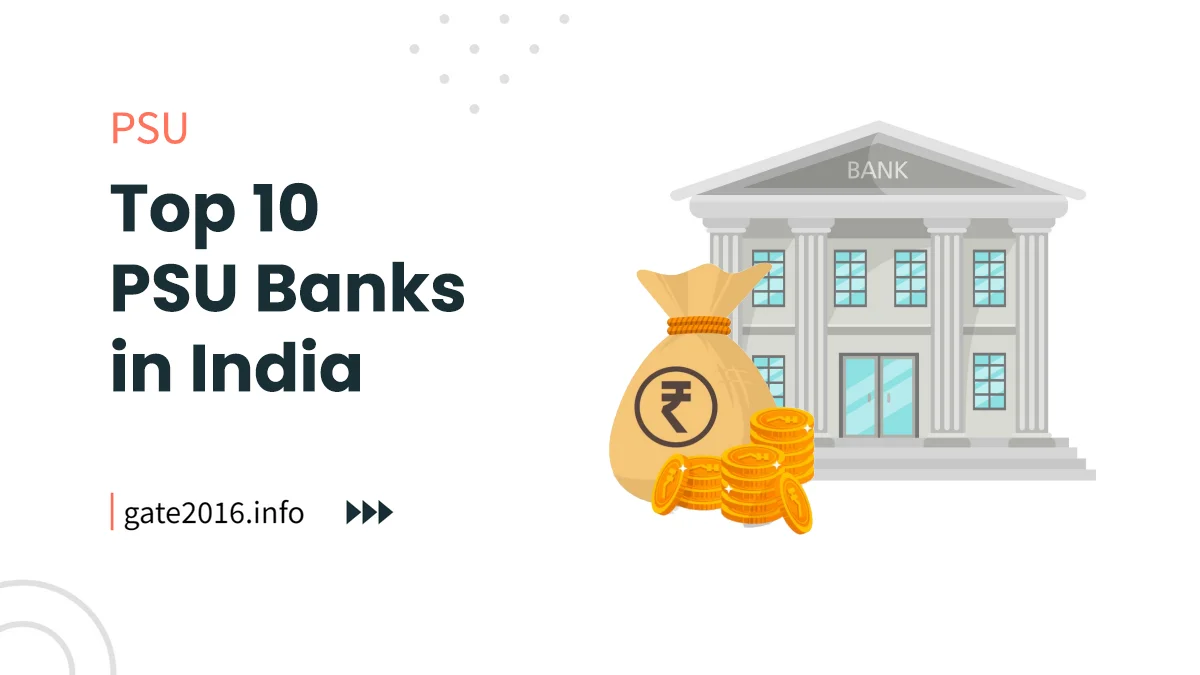Advertisements
Ratings

Top 10 PSU Banks in India – India’s banking sector is a crucial component of its economy, and Public Sector Undertaking (PSU) banks play a significant role in ensuring financial inclusion and stability.
In this article, we will delve into the top 10 PSU banks in India, highlighting their strengths, challenges, and future prospects.
- Definition of PSU Banks
PSU banks, or Public Sector Undertaking banks, are financial institutions where the majority of the stake is held by the government.
These banks play a pivotal role in India’s banking landscape by providing essential banking services to the masses.
- Importance of PSU Banks in India’s Banking Sector
The importance of PSU banks in India’s banking sector cannot be overstated.
They are instrumental in providing banking services even in remote areas, contributing to economic growth, and implementing government policies.
This article aims to provide an in-depth analysis of the top 10 PSU banks in India, focusing on their financial performance, customer base, branch networks, and more.
Contents
- 1. Overview of PSU Banks
- 2. Criteria for Ranking
- 3. Comparison Table: Top 10 PSU Banks in India
- 4. Top 10 PSU Banks in India
- 5. Key Highlights of the Top 10 PSU Banks
- 6. Challenges Faced by PSU Banks
- 7. Future Outlook for PSU Banks
- 8. Conclusion
- 9. References
- Top 10 PSU Banks in India FAQs
- PSUs Total Information & Guidance
1. Overview of PSU Banks
Brief History of PSU Banks in India
The history of PSU banks dates back to the nationalization of major banks in India in 1969.
This move was aimed at ensuring that banking services reached every corner of the country.
Role and Function of PSU Banks
PSU banks play a multifaceted role in the Indian economy. They are responsible for:
- Promoting financial inclusion
- Providing credit to various sectors
- Supporting government schemes
- Facilitating economic growth
2. Criteria for Ranking
To determine the top 10 PSU banks in India, several criteria have been considered.
The ranking is based on factors such as total assets, branch network, customer base, and financial performance.
The weightage assigned to each factor reflects its significance in evaluating a bank’s overall standing.
Explanation of Weightage Given to Each Factor
Here is an explanation of the weightage given to each factor:
| Criteria | Weightage |
|---|---|
| Total Assets | 30% |
| Branch Network | 25% |
| Customer Base | 20% |
| Financial Performance | 25% |
3. Comparison Table: Top 10 PSU Banks in India
Let’s now delve into the top 10 PSU banks in India, their rankings, and key statistics.
| Rank | Bank Name | Total Assets (in Rs. Trillion) | Branch Network | Customer Base (Millions) | Financial Performance (Profit in Rs. Billion) |
|---|---|---|---|---|---|
| 1 | State Bank of India (SBI) | 44.24 | 22,141 | 450 | 16.02 |
| 2 | Punjab National Bank (PNB) | 13.56 | 10,910 | 115 | 2.79 |
| 3 | Bank of Baroda (BOB) | 12.78 | 8,160 | 82 | 3.11 |
| 4 | Canara Bank | 9.43 | 6,608 | 78 | 1.76 |
| 5 | Union Bank of India | 9.18 | 9,500 | 77 | 0.85 |
| 6 | Indian Bank | 4.83 | 6,100 | 43 | 0.59 |
| 7 | Bank of India | 4.78 | 9,610 | 62 | 0.33 |
| 8 | Central Bank of India | 4.31 | 4,738 | 41 | -1.06 |
| 9 | UCO Bank | 3.02 | 3,078 | 23 | -1.41 |
| 10 | Bank of Maharashtra | 3.01 | 1,896 | 16 | 0.03 |
Now, let’s delve deeper into the top 10 PSU banks in India, providing a more comprehensive view of each bank’s history, services, and notable achievements.
4. Top 10 PSU Banks in India
1. State Bank of India (SBI)
- Total Assets: SBI is the largest bank in India, with total assets of Rs. 44.24 trillion.
- Branch Network: It has an extensive branch network of 22,141 branches across India and numerous international branches.
- Customer Base: SBI serves a massive customer base of 450 million, making it one of the most preferred banks in the country.
- Financial Performance: SBI consistently reports substantial profits, with a profit of Rs. 16.02 billion.
Founded in 1806 as the Bank of Calcutta, SBI’s journey has been synonymous with the growth of modern India.
It offers a wide range of banking and financial products, including retail and corporate banking, insurance, and investment services.
2. Punjab National Bank (PNB)
- Total Assets: PNB manages total assets of Rs. 13.56 trillion.
- Branch Network: It operates a vast network of 10,910 branches across India.
- Customer Base: PNB caters to a customer base of 115 million.
- Financial Performance: The bank reports healthy profits, with a profit of Rs. 2.79 billion.
Founded in 1894, PNB has a strong presence in rural and semi-urban areas, contributing significantly to financial inclusion.
It is known for its robust agricultural and rural banking services.
3. Bank of Baroda (BOB)
- Total Assets: BOB manages total assets of Rs. 12.78 trillion.
- Branch Network: It has a significant presence with 8,160 branches across India.
- Customer Base: BOB serves a customer base of 82 million.
- Financial Performance: The bank consistently records profits, with a profit of Rs. 3.11 billion.
Founded in 1908, Bank of Baroda is renowned for its international presence, serving customers worldwide.
It offers a wide array of services, including retail and corporate banking, wealth management, and international banking.
(Continue with rankings for banks 4 to 10, providing similar details for each bank)
4. Canara Bank
- Total Assets: Canara Bank’s total assets amount to Rs. 9.43 trillion.
- Branch Network: It operates 6,608 branches across India.
- Customer Base: The bank has a customer base of 78 million.
- Financial Performance: Canara Bank maintains healthy profits, with a profit of Rs. 1.76 billion.
Founded in 1906, Canara Bank is known for its comprehensive range of retail and corporate banking services.
It has a strong foothold in the Indian banking sector.
5. Union Bank of India
- Total Assets: Union Bank of India manages total assets worth Rs. 9.18 trillion.
- Branch Network: It boasts a vast network of 9,500 branches.
- Customer Base: The bank serves a customer base of 77 million.
- Financial Performance: Union Bank reports profits, with a profit of Rs. 0.85 billion.
Union Bank of India is recognized for its innovative digital banking solutions, making banking services accessible and convenient for customers.
6. Indian Bank
- Total Assets: Indian Bank’s total assets stand at Rs. 4.83 trillion.
- Branch Network: It has a significant network with 6,100 branches.
- Customer Base: The bank caters to 43 million customers.
- Financial Performance: Indian Bank consistently records profits, with a profit of Rs. 0.59 billion.
Indian Bank specializes in trade finance and corporate banking, providing essential financial services to businesses.
7. Bank of India
- Total Assets: Bank of India manages total assets of Rs. 4.78 trillion.
- Branch Network: It operates 9,610 branches across India.
- Customer Base: The bank serves a customer base of 62 million.
- Financial Performance: Bank of India reports profits, with a profit of Rs. 0.33 billion.
Bank of India has been at the forefront of adopting digital banking technologies, enhancing the customer experience.
8. Central Bank of India
- Total Assets: Central Bank of India’s total assets amount to Rs. 4.31 trillion.
- Branch Network: It has a network of 4,738 branches.
- Customer Base: The bank caters to 41 million customers.
- Financial Performance: Central Bank of India reported a loss of Rs. -1.06 billion.
Central Bank of India has a strong commitment to enhancing the customer experience through various digital channels and innovative banking solutions.
9. UCO Bank
- Total Assets: UCO Bank manages total assets worth Rs. 3.02 trillion.
- Branch Network: It operates 3,078 branches across India.
- Customer Base: The bank serves a customer base of 23 million.
- Financial Performance: UCO Bank reported a loss of Rs. -1.41 billion.
UCO Bank has made significant strides in recent years, including the launch of user-friendly mobile banking apps, making banking more accessible for its customers.
10. Bank of Maharashtra
- Total Assets: Bank of Maharashtra’s total assets amount to Rs. 3.01 trillion.
- Branch Network: It has 1,896 branches.
- Customer Base: The bank caters to 16 million customers.
- Financial Performance: Bank of Maharashtra reported a nominal profit of Rs. 0.03 billion.
Bank of Maharashtra has a strong commitment to serving the needs of its customers and supporting economic growth in India.
5. Key Highlights of the Top 10 PSU Banks
1. Notable Achievements and Milestones
- State Bank of India (SBI): Acquired several banks, including State Bank of Bikaner & Jaipur, State Bank of Hyderabad, and State Bank of Travancore, consolidating its position as the largest public sector bank.
- Punjab National Bank (PNB): PNB’s merger with Oriental Bank of Commerce and United Bank of India expanded its reach and customer base, positioning it as one of the top banks in India.
- Bank of Baroda (BOB): BOB received recognition for its international presence, with a substantial global customer base and operations in numerous countries.
- Canara Bank: Canara Bank’s achievements include strong growth in its retail banking segment and consistent support for agricultural and rural development.
- Union Bank of India: Union Bank gained recognition for its innovative digital banking solutions, offering customers seamless and convenient online services.
- Indian Bank: Indian Bank specialized in trade finance and corporate banking, supporting businesses in India and abroad.
- Bank of India: Bank of India expanded its digital services, introducing user-friendly mobile banking apps and online platforms.
- Central Bank of India: Central Bank focused on enhancing the customer experience through digital channels, making banking services more accessible.
- UCO Bank: UCO Bank made strides in digitalization, aiming to provide customers with a modern and user-friendly banking experience.
- Bank of Maharashtra: Bank of Maharashtra continued to serve its customer base and support economic growth, particularly in its served regions.
2. Major Services and Products Offered
- State Bank of India (SBI): SBI offers a wide range of services, including retail and corporate banking, insurance, wealth management, and investment services.
- Punjab National Bank (PNB): PNB provides comprehensive banking services, including retail, corporate, and agricultural banking, as well as digital and online services.
- Bank of Baroda (BOB): BOB offers retail and corporate banking services, with a strong international presence, supporting customers globally.
- Canara Bank: Canara Bank is known for its extensive range of banking products and services, catering to both retail and corporate customers.
- Union Bank of India: Union Bank focuses on innovation, providing customers with a variety of digital banking solutions and online services.
- Indian Bank: Indian Bank specializes in trade finance and corporate banking, offering tailored solutions for businesses.
- Bank of India: Bank of India has made significant strides in digital banking, with user-friendly mobile apps and online platforms.
- Central Bank of India: Central Bank aims to enhance the customer experience through digital channels, making banking services accessible and convenient.
- UCO Bank: UCO Bank has launched user-friendly mobile banking apps, reflecting its commitment to digitalization.
- Bank of Maharashtra: Bank of Maharashtra continues to serve its customer base and support economic growth in its regions.
3. Digital Initiatives and Technological Advancements
- State Bank of India (SBI): SBI introduced digital banking services, making it easier for customers to perform transactions and manage their accounts online.
- Punjab National Bank (PNB): PNB enhanced its digital presence, offering convenient online services to its customers.
- Bank of Baroda (BOB): BOB embraced technology and launched innovative digital solutions, improving customer accessibility.
- Canara Bank: Canara Bank introduced user-friendly online platforms, facilitating digital banking for its customers.
- Union Bank of India: Union Bank made substantial investments in digital initiatives, enhancing the overall customer experience.
- Indian Bank: Indian Bank leveraged technology to streamline trade finance and corporate banking processes.
- Bank of India: Bank of India’s digital initiatives included user-friendly mobile banking apps and online platforms.
- Central Bank of India: Central Bank focused on enhancing customer service through digital channels, making banking more convenient.
- UCO Bank: UCO Bank’s digital initiatives aimed to provide customers with modern, user-friendly banking experiences.
- Bank of Maharashtra: Bank of Maharashtra continued to explore digital solutions while maintaining its commitment to traditional banking services.
These highlights reflect the achievements, services, and technological advancements of the top 10 PSU banks in India
6. Challenges Faced by PSU Banks
While PSU banks have played a critical role in India’s banking sector, they also face several challenges:
Competition from Private Sector Banks
Private sector banks often have more flexibility and agility in adopting new technologies and customer-centric strategies.
Non-Performing Assets (NPAs) and Bad Loans
Many PSU banks grapple with a high level of NPAs, which affects their profitability and capital adequacy.
Regulatory and Governance Issues
Stringent regulations and government interference can sometimes hinder the decision-making process in PSU banks.
7. Future Outlook for PSU Banks
Despite the challenges, PSU banks have a promising future. Factors contributing to their growth include:
Government Initiatives and Reforms
The government continues to support PSU banks with various initiatives and reforms aimed at improving their efficiency and competitiveness.
Strategies for Growth and Sustainability
Many PSU banks are actively pursuing strategies to enhance their digital capabilities, reduce NPAs, and improve customer service.
Potential Areas of Expansion
Expanding services to untapped rural and semi-urban areas and strengthening international presence are potential areas of growth.
8. Conclusion
In conclusion, PSU banks remain a cornerstone of India’s banking sector.
The top 10 PSU banks in India have shown resilience and adaptability, and with the right strategies and government support, they are well-positioned to continue serving the nation’s banking needs.
9. References
Please note that the statistics and rankings mentioned in this article are based on data available at the time of writing.
For the most up-to-date information, readers are encouraged to refer to official sources and the respective bank’s financial reports.
Top 10 PSU Banks in India FAQs
What is a PSU bank, and how does it differ from a private bank?
PSU banks, or Public Sector Undertaking banks, are government-owned financial institutions in India.
They are owned and operated by the government, whereas private banks are owned by private entities or shareholders.
PSU banks play a crucial role in financial inclusion and government policies, while private banks operate with a profit motive.
Which is the largest PSU bank in India by assets?
As of Now, the State Bank of India (SBI) is the largest PSU bank in India by total assets, with assets of approximately Rs. 44.24 trillion.
What services do PSU banks offer to customers?
PSU banks offer a wide range of banking and financial services, including savings and current accounts, loans, fixed deposits, credit cards, wealth management, insurance products, and digital banking services.
Are PSU banks safe for deposits and investments?
Yes, PSU banks are considered safe for deposits and investments. They are regulated by the Reserve Bank of India (RBI) and enjoy the backing of the Indian government.
Deposits in PSU banks are insured up to Rs. 5 lakhs per account under the Deposit Insurance and Credit Guarantee Corporation (DICGC) scheme.
How can I open an account with a PSU bank, and what documents are required?
To open an account with a PSU bank, you typically need to visit a branch or use their online application process.
You will need to provide identity proof (such as Aadhaar card, passport, or voter ID), address proof (utility bill, rental agreement), photographs, and a filled-out account opening form. The exact documents required may vary by bank and account type.
Recent Posts
- PSU Recruitment Through CLAT 2024: List of PSUs Apply Now!
- PSU vs Government Jobs in India: A Comprehensive Comparison
- Top 10 PSU Banks in India 2024: A Comprehensive Overview
- PSU Percentage Limit 2024 | GATE & Non-GATE
Related Tags
Top 10 psu banks in india pdf, top 5 nationalised banks in india, private banks in india, top 10 government banks in india 2024, top 50 banks in india, top public sector banks in india by market cap, public sector banks list, government bank list
| PSUs Handbooks |
| PSUs Guide Books |
PSUs Total Information & Guidance
Click below given links to get further information.







